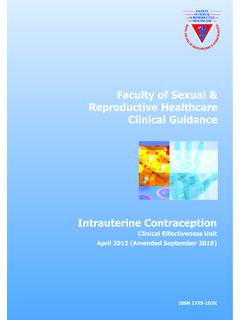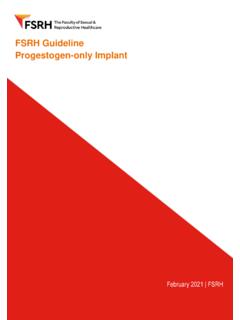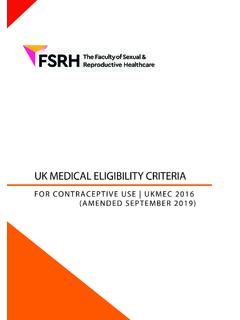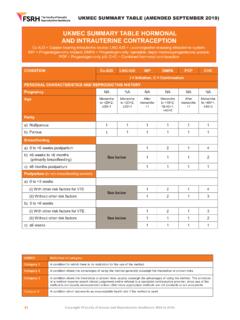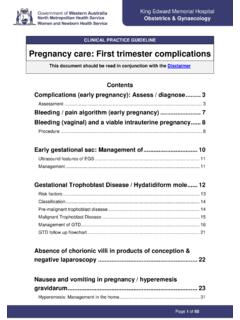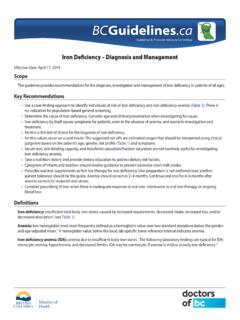Transcription of Faculty of Sexual & Reproductive Healthcare Clinical Guidance
1 Faculty of Sexual & Reproductive HealthcareClinical GuidanceFACULTYOF Sexual &REPRODUCTIVEHEALTHCAREP roblematic bleeding with Hormonal ContraceptionClinical Effectiveness UnitJuly 2015 ISSN 1755-103 XPublished by the Faculty of Sexual & Reproductive HealthcareRegistered in England No. 2804213 and Registered Charity No. 1019969 First published in 2015 Copyright Faculty of Sexual & Reproductive Healthcare 2015 Permission granted to reproduce for personal and educational use only. Commercial copying, hiring and lending are reference numberTitleAuthor/publisherPublication dateDescription/descriptorsCross referencesSuperseded documentsUpdate/amendment levelReview date04/FSRH/Problematic bleeding /2015 Problematic bleeding with Hormonal ContraceptionFaculty of Sexual & Reproductive Healthcare (FSRH)July 2015 Irregular bleeding , bleeding , breakthrough bleeding , spottingUnited Kingdom Medical Eligibility Criteria (UKMEC) 2009 management of Unscheduled bleeding in women Using HormonalContraception 2009 Partial amendment no changes to recommendations and practiceJuly 2020 GRADING OF RECOMMENDATIONSE vidence based on randomised controlled trialsEvidence based on other robust experimental or observational studiesEvidence is limited but the advice relies on expert opinion and has theendorsement of respected authoritiesGood Practice Point where no evidence exists but where best practice is basedon the Clinical experience of the guideline groupABC CONTENTSG rading of RecommendationsIFCA bbreviations UsediiSummary of Key Recommendations iii1 Purpose and Scope 12 Background23 Expected bleeding Patterns Associated with Hormonal Contraceptives 24 Medical Eligibility for Contraceptive Use in women with Abnormal Bleeding45 management of women with Problematic Clinical Sexually
2 Transmitted Cervical Pregnancy Clinical When examination may not be When is examination required? When is further investigation required? Endometrial Pelvic ultrasound scan and hysteroscopy86 Treatment Combined hormonal Progestogen-only Progestogen-only Progestogen-only injectable Progestogen-only Levonorgestrel-releasing intrauterine system12 References13 Appendix 1: Development of CEU Guidance 16 Questions for Continuing Professional Development 17 Auditable Outcomes for Problematic bleeding with Hormonal Contraception 19 Comments and Feedback on Published GuidanceIBCCEU Guidance FSRH 2015iNICE has accredited the process used by the Faculty of Sexual & Reproductive Healthcareto produce its Problematic bleeding with Hormonal Contraception. Accreditation is valid for5 years from May 2011. More information on accreditation can be viewed full details on our accreditation GUIDANCEii FSRH 2015 ABBREVIATIONS USEDCEUC linical Effectiveness UnitCHCcombined hormonal contraception/contraceptiveCIconfidence intervalCOCcombined oral contraception/contraceptiveCVRcombined vaginal ringDMPA depot medroxyprogesterone acetateDSGdesogestrelEEethinylestradiolF SRHF aculty of Sexual & Reproductive HealthcareHMBheavy menstrual bleedingIMintramuscularIUSintrauterine systemLNGlevonorgestrelLNG-IUSlevonorges trel-releasing intrauterine systemNHSCSPN ational Health Service Cervical Screening ProgrammeNICEN ational Institute for Health and Care ExcellenceNSAIDnon-steroidal anti-inflammatory drugPOPprogestogen-only pillRCTrandomised controlled trialRRrelative riskSCsubcutaneousSTIsexually transmitted infectionUKMECU nited Kingdom Medical Eligibility CriteriaWHOW orld Health OrganizationWHOSPRW orld Health Organization Selected
3 Practice Recommendations for Contraceptive UseSUMMARY OF KEY RECOMMENDATIONSB efore starting hormonal contraception, women should be advised about the bleedingpatterns expected both initially and in the longer Clinical history should be taken from women using hormonal contraception who haveproblematic bleeding to identify the possibility of an underlying contraception users with problematic bleeding who are at risk of sexuallytransmitted infections (STIs) should be tested for Chlamydia trachomatisas a for Neisseria gonorrhoeawill depend on Sexual risk, local prevalence andavailability of dual using hormonal contraception who have problematic bleeding and areeligible for, but not participating in, a National Health Service Cervical ScreeningProgramme (NHSCSP) should have a cervical pregnancy test is indicated for sexually active women using hormonal contraceptionwith problematic examination may not be required in women attending with problematic bleedingwho are using hormonal contraception, if after taking a Clinical history there are no riskfactors for STIs, no concurrent symptoms suggestive of underlying causes, they areparticipating in an NHSCSP, and have had no more than 3 months of speculum examination should be performed for women using hormonalcontraception who have problematic bleeding if they have persistent bleeding or achange in bleeding after at least 3 months of use.
4 If medical treatment has failed or ifthey have not participated in an endometrial biopsy should be considered in women aged 45 years or in womenaged <45 years with risk factors for endometrial cancer who have persistentproblematic bleeding after the first 3 months of use of a method or who present with achange in bleeding role of endometrial polyps, fibroids or ovarian cysts as a cause of problematicbleeding is uncertain. Nevertheless, for all women using hormonal contraception whohave problematic bleeding , if such a structural abnormality is suspected a transvaginalultrasound scan and/or hysteroscopy may be is not generally recommended that a combined oral contraceptive pill (COC) bechanged within the first 3 months of use as bleeding disturbances often settle in women using a COC the lowest dose of ethinylestradiol (EE) to provide good cyclecontrol should be used. However, the dose of EE can be increased to a maximum of35 g to provide good cycle is common in the initial months of progestogen-only method use and maysettle without treatment.
5 If treatment encourages a woman to continue with themethod it may be Guidance FSRH 2015iii C There is no evidence that changing the type and dose of progestogen-only pill (POP)will improve problematic bleeding ; bleeding patterns may vary with different POPpreparations and this may help some women using a progestogen-only injectable contraceptive who have problematicbleeding, mefenamic acid 500 mg twice daily (or as licensed up to three times daily)for 5 days can reduce the length of a bleeding episode but has little effect on bleedingin the longer women with problematic bleeding using a progestogen-only injectable, implant orintrauterine system (IUS) who wish to continue with the method and are medicallyeligible, a COC may be tried for 3 months (this can be used in the usual cyclic manneror continuously without a pill-free interval and is outside the product licence).Longer-term use of COC has not been studied in relation to the progestogen-onlyinjectable, implant or IUS methods.
6 If bleeding recurs following 3 months use of COC,longer-term use is a matter of Clinical GUIDANCEiv FSRH 2015 BC Faculty of Sexual & Reproductive HealthcareClinical Effectiveness UnitA unit funded by the FSRH and supported by NHS Greater Glasgow & Clyde/ NHS Lothian to provide Guidance on evidence-based practiceFSRH Guidance (July 2015)Problematic bleeding with Hormonal Contraception(Revision due by July 2020)1 Purpose and ScopeThis Guidance brings together evidence and expert opinion on the management ofproblematic bleeding in women using hormonal contraception [ the combined oralcontraceptive pill (COC), transdermal patch, combined vaginal ring (CVR), progestogen-onlypill (POP), progestogen-only injectable, progestogen-only implant or intrauterine system (IUS)].The term problematic bleeding in this Guidance refers to breakthrough bleeding , spotting,prolonged or frequent bleeding (Box 1).1 This document supersedes previous Faculty of Sexual & Reproductive Healthcare (FSRH) Guidance on the management of unscheduled main changes from the previous Guidance are: Information on the CVR Information on Sayana Press , a subcutaneous progestogen-only injectable Information on Jaydess , a mg levonorgestrel IUS (LNG-IUS) Information on estradiol-containing management of women who present with problematic bleeding while using hormonalcontraception is challenging.
7 For many women problematic bleeding will be due to thecontraceptive method itself: the pattern and duration of bleeding and the likelihood of thissettling will vary with the method used (Table 1). women may consider that the contraceptiveand non-contraceptive benefits of a method outweigh the inconvenience of unpredictablebleeding. After reassurance that there is no serious underlying cause, they may be happy tocontinue using the management of women with problematic bleeding in the 3 6 months after starting a newmethod of hormonal contraception may differ from that of women who continue to haveproblematic bleeding in the longer term or who present with a change in bleeding pattern. Aclinical history (Box 2) should highlight possible underlying causes and provide a guide to themost appropriate examination, investigation and treatment options required. Reassuringly, incommunity populations, endometrial cancer is very rare in women of Reproductive age whoCEU Guidance FSRH 20151 Box 1 Clinically important bleeding patterns in women aged 15 44 years1 Scheduled bleedingMenstruation or regular withdrawal bleeding with combined hormonal contraception (CHC)Other bleeding patternsFrequent bleeding More than five bleeding episodesawithin a reference periodbInfrequent bleeding Fewer than three bleeding episodesawithin a reference periodbProlonged bleeding bleeding episodealasting 14 days or moreSpottingVaginal discharge containing blood, that may not require the use of sanitary protectionBreakthrough bleeding Unscheduled bleeding in women using CHCA menorrhoeaNo bleeding or spotting days throughout the 90-day reference periodbaBleeding episode: one or more consecutive days of bleeding , bounded by bleed-free period.
8 A 90-day period of time during use of a hormonal contraceptive using hormonal contraception and who do not have risk factors for endometrial cancer(such as obesity, polycystic ovarian syndrome or diabetes). Cervical cancer is also rare in thispopulation, especially in women who comply with National Health Service Cervical ScreeningProgrammes (NHSCSPs).A management plan is outlined that can be tailored to the individual woman (Figure 1).Evidence to support the management plan is provided in this Guidance . It is a guide only andcan be used to develop a care pathway taking account of local expertise and ease ofreferral/access to specialist services and within this document are based on the best available evidence and theconsensus opinion of experts. A key to the grading of recommendations, derived from levels ofevidence, is provided on the inside front cover of this document. Details of the methods usedby the Clinical Effectiveness Unit (CEU) in developing this Guidance are outlined in Appendix 1and in the CEU section of the FSRH website ( ).
9 The recommendations includedshould be used to guide Clinical practice but are not intended to serve alone as a standard ofmedical care or to replace Clinical judgement in the management of individual BackgroundDuring a normal menstrual cycle the endometrium is exposed to circulating sex steroids. It is thesequential exposure of the endometrium to the natural steroids, estradiol and progesterone,that leads to characteristic histological exposure during the follicular phase is responsible for endometrial proliferation. Exposureto progesterone in the luteal phase results in secretory differentiation. Progesterone is anti-estrogenic and inhibits endometrial growth and glandular differentiation. It is the withdrawal ofestradiol and progesterone, in the absence of pregnancy, which triggers the onset of administration of sex steroids, in the form of hormonal contraception, dramaticallyinfluences endometrial exact mechanisms of problematic bleeding associated with hormonal contraception arelargely unexplained.
10 The evidence to date implicates superficial blood vessel fragility within theendometrium and local changes in endometrial steroid response, structural integrity, tissueperfusion and local angiogenic factors as contributing there are no establishedlong-term interventions available to manage problematic bleeding , a greater understandingof the mechanisms involved is Expected bleeding Patterns Associated with Hormonal ContraceptionPre-method counselling about expected bleeding patterns may reduce concerns andencourage continued use of a given method of hormonal ,7If bleeding patternsfall outside the expected normal patterns associated with different contraceptive methodsat different durations of use (outlined in Table 1), examination, investigation or treatment maybe GUIDANCE2 FSRH 2015 Before starting hormonal contraception, women should be advised about the bleedingpatterns expected both initially and in the longer Guidance FSRH 20153 ContraceptivemethodCombined hormonalcontraception (pill,patch or ring)Progestogen-only pillProgestogen-onlyinjectable (IM andSC)Progestogen-onlyimplantLevonorgest rel-releasing intrauterinesystem (LNG-IUS)52 mg (Mirena )LNG-IUS mg (Jaydess ) bleeding patterns in women in thefirst 3 monthsUp to 20% of COC users haveirregular bleedingBleeding is unpredictableWith traditional POPs, one-third ofwomen have a change inbleeding12A comparative study of DSG LNGPOP reported that frequentbleeding, prolonged bleeding andinfrequent bleeding were morecommon in DSG users than LNGusers in the first reference period of90 days13 bleeding disturbances (spotting,light, heavy or prolongedbleeding)


